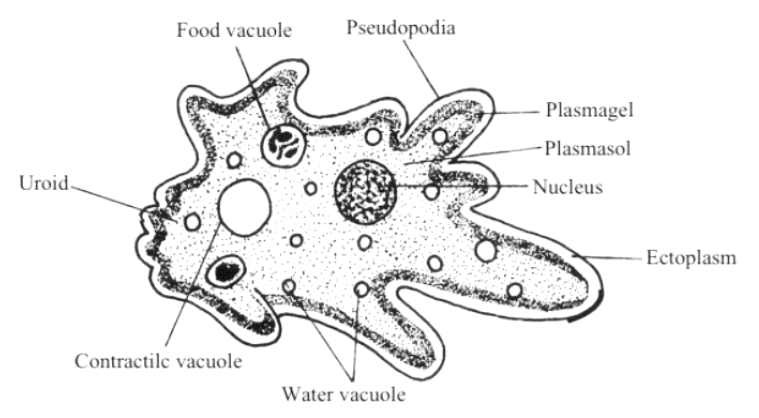
Observe the diagram and explain the formation of cyst in Amoeba during multiple fission.


Answer
471.3k+ views
Hint: Multiple fission occurs by the repeated division of the nucleus inside the cell. The nucleus of the parent cell divides and this process occurs in unfavorable conditions. The parent cell converts into a cyst which contains many small daughter cells.
Complete answer:
Reproduction: It is the process in which organisms give rise to young ones similar to itself. Amoeba is a unicellular organism belonging to the kingdom of protozoa. So, in this type of organism asexual reproduction takes place.
Binary fission and multiple fission is a type of asexual reproduction.
So, this question we will study about the multiple fission in amoeba.
Multiple fission is the asexual reproductive in which many individuals are formed of the parent cell. The nucleus repeatedly divides in this method to create a large number of nuclei. Every nucleus absorbs a little amount of cytoplasm and forms a membrane around each structure. All the daughter cells are similar and identical in dimension.
Amoeba reproduces mainly by binary fission however, a method known as multiple fission is adopted by the unicellular organism like amoeba to survive and reproduce under favorable conditions. When the unfavorable conditions arise, amoeba withdraws its pseudopodia and becomes almost round. It secretes a hard covering called cyst. The cyst forms a thick protective coat around it.
The nucleus present inside the cyst undergoes multiple divisions to form many nuclei. After the completion of nuclear division the division of cytoplasm occurs. Hence, large amounts of new daughter cells are formed. On return of favorable conditions, the cyst burst open to release these daughter cells.
Note: Some multicellular organisms have amoeboid cells only in particular phases of life or use amoeboid movements for specialized functions. In the immune system of humans and other animals, amoeboid white blood cells pursue invading organisms, such as bacteria and pathogenic protists, and engulf them by phagocytosis.
Complete answer:
Reproduction: It is the process in which organisms give rise to young ones similar to itself. Amoeba is a unicellular organism belonging to the kingdom of protozoa. So, in this type of organism asexual reproduction takes place.
Binary fission and multiple fission is a type of asexual reproduction.
So, this question we will study about the multiple fission in amoeba.
Multiple fission is the asexual reproductive in which many individuals are formed of the parent cell. The nucleus repeatedly divides in this method to create a large number of nuclei. Every nucleus absorbs a little amount of cytoplasm and forms a membrane around each structure. All the daughter cells are similar and identical in dimension.
Amoeba reproduces mainly by binary fission however, a method known as multiple fission is adopted by the unicellular organism like amoeba to survive and reproduce under favorable conditions. When the unfavorable conditions arise, amoeba withdraws its pseudopodia and becomes almost round. It secretes a hard covering called cyst. The cyst forms a thick protective coat around it.
The nucleus present inside the cyst undergoes multiple divisions to form many nuclei. After the completion of nuclear division the division of cytoplasm occurs. Hence, large amounts of new daughter cells are formed. On return of favorable conditions, the cyst burst open to release these daughter cells.
Note: Some multicellular organisms have amoeboid cells only in particular phases of life or use amoeboid movements for specialized functions. In the immune system of humans and other animals, amoeboid white blood cells pursue invading organisms, such as bacteria and pathogenic protists, and engulf them by phagocytosis.
Recently Updated Pages
Basicity of sulphurous acid and sulphuric acid are

Master Class 12 Economics: Engaging Questions & Answers for Success

Master Class 12 Maths: Engaging Questions & Answers for Success

Master Class 12 Biology: Engaging Questions & Answers for Success

Master Class 12 Physics: Engaging Questions & Answers for Success

Master Class 12 Business Studies: Engaging Questions & Answers for Success

Trending doubts
Which are the Top 10 Largest Countries of the World?

Draw a labelled sketch of the human eye class 12 physics CBSE

Differentiate between homogeneous and heterogeneous class 12 chemistry CBSE

What is a transformer Explain the principle construction class 12 physics CBSE

What are the major means of transport Explain each class 12 social science CBSE

How much time does it take to bleed after eating p class 12 biology CBSE




